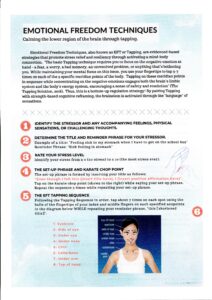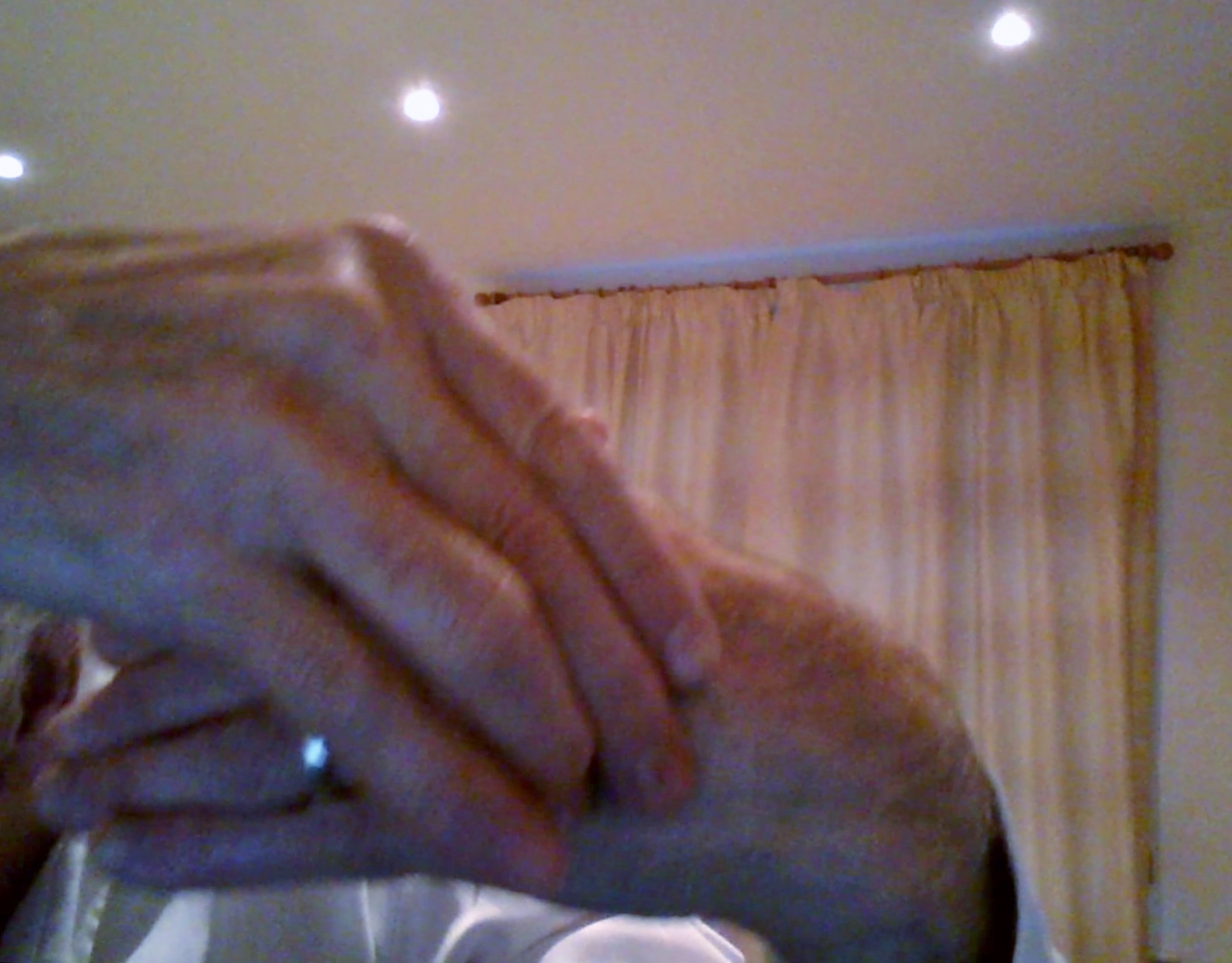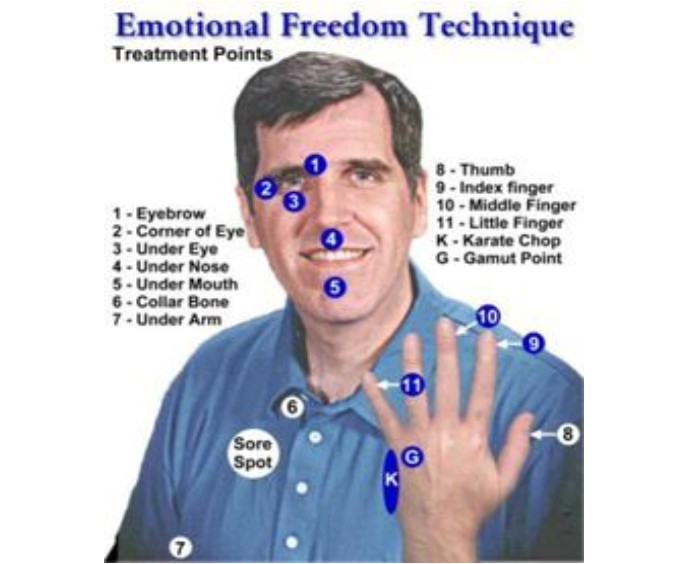There are a number of strange safe experiments that can be developed that help different folk. Here I will look at ‘tapping’ – the use of gentle and rhythmic touches to parts of our body in order to reinforce a change of behaviour or outlook.
It is not clear how ‘tapping’ works but experience tells it does for some people, some of the time, but not all. Certainly, tapping is harmless and the only argument is whether it can do good!!
A specialist in Tapping is Nick Ortner. I have his book and it might well help some people. His work evolved from Emotional Freedom Therapies (EFT) in which I was once trained and accredited, but other tapping experiments have emerged from different ‘schools’ of psychology and include:
Neuro-Linguistic Programming (NLP)
NLP has some interesting things to say about ‘anchoring’. Here is an illustration of some ‘anchors’ intended to connect and reinforce positive feelings and outcomes.

Tapping anchors are to be found in the third column, above – the kinaesthetic – touch and feel box. It will not surprise you to learn that anchors can be reinforced by using two or more ‘channels’ to help build an even stronger connection.
When might this safe experiment work? An obvious time is when we practise affirmations.
When we are using affirmations – short and positive statements about ourselves – tapping can reinforce the words spoken. You can take that reinforcement a step further; speaking the words, doing the tapping and looking at yourself in a mirror all at the same time. This can produce a level of reinforcement that can prove embarrassing!!
Research is not too kind about tapping strategies, see:
https://psycnet.apa.org/record/1990-10473-001
….. but a more detailed account of anchoring practises can be found at:
How anchoring is related to some of the safe experiments I have discussed on this web site. In my own language, the pre-frontal cortex is part of our younger and smarter sibling and the threat/fear system belongs with our older, and not so smart sibling. For more on this, take a look at:
https://your-nudge.com/managing-our-own-high-emotions/
https://your-nudge.com/anger-can-be-ok/
https://your-nudge.com/polyvagal-theory-what-are-the-practical-implications/
The next illustration draws a link between an anchor and the rest of our body – through our autonomic nervous system (ANS).

The inference is, as I understand it, is that tapping can initiate engagement of the ventral vagus system. This impacts on the top half of our body – the face and chest.
Tapping can help us find that micro-second needed to step back from fight, flight and freeze. That time we are buying can be just long enough to feel a reward from doing that something just a little bit different. The art of doing something just a little bit different is at the heart of safe experimenting.
Schools of psychology that help here are called the Energy Therapies.
TAPPING POINTS
A useful reminder of the ‘map’ of EFT Tapping points comes to me via a colleague:

As it stands, the chart is not easy to read with much detail in it. You may want to search the Internet on this topic.
I have already mentioned Nick Ortner’s name and there are other EFT guides are available in substantial detail, free of charge; for example https://eftinternational.org/wp-content/uploads/EFT-International-Free-Tapping-Manual.pdf
There is some scepticism about Energy Psychology in the worlds of therapy. A leading light in the UK, in this field, is Dr Phil Mollen, a practitioner with a background in both conventional therapy training and ‘energy’ psychology. He has interesting things to say about both, and his web site is worth researching.
Tapping, as a technique used by the ‘energy’ schools, seems to produce some visible results, for some people. My observation, here, is simple: if it works, don’t knock it. If it seems not to work, don’t pack it in immediately. Have you ever practised something new and got it right first time? Do try something out for a reasonable amount of time before moving on to something new.
Keep in mind that small victories are easily missed and they may come from any quarter. It is possible to prime ourselves to see things go wrong simply because it appears too zany. I know they say ‘if something sounds too good to be true, then it is likely to be so‘. Even so, as long as you are not out of pocket, do try something that is just a little bit different.
What do you have to lose? Left-field experiments continue to surprise me, even today.
EXPERIMENT WITH TAPPING AND BODY SCANNING
You can use tapping as a development of the Body Scan and the ‘just noticing’ experiments. The difference is that once you become aware of a negative thought, you can do something in addition to the affirmation work I have mentioned already.
Observation shows this experiment can reduce the symptoms of anxiety.
What you do is to tap the back of one hand with one or two fingers on the other hand. At the same time, he can AFFIRM yourself with a message in your head. Thus:

Affirmation work, with tapping
Copy this position approximately and then tapping gently and rhythmically just below the back of the (ring) finger, as illustrated. Repeat the affirmation:
“although I am feeling [name the feeling], I can still deeply and completely accept myself”
Bear in mind this may be difficult to take seriously at first. It may feel silly and embarrassing. Remember that ’embarrassed’ is a socially shaped feeling so name THAT reaction. Continue, despite any discomfort, for a short period. Engage the controlled breathing and use the body scan to notice your thoughts, feelings and sensations.
It is likely, with practice, that you will notice a reduction in negative feelings when you use the Subjective Unit of Discomfort (SUD) to measure changes, over time.
From this experience, you may find an the opportunity to revisit your characteristic feelings as well as some of your negative thoughts and to consider what steps need to be taken to change those beliefs.
What I find helpful about Tapping is that it offers a practical approach that seems to work well with the safe experiments focused on meditation, and the use of Subjective Units of Discomfort (SUDS). Also, it gives respect to the ‘small’ in small, safe experiment. There is a useful App from Nick’s website available for any-one with a smartphone.
AN EXPERIMENT
Design a chart to monitor some information about anxiety events. As before, have columns to note who you were with, where you were and what was said or done. Use the SUDs to measure the intensity of your feeling. Then scan your thoughts and look for any negative belief associated with this experience, e.g. I’ll never get away from this horrid experience. Record that belief and note how strongly you believe it where 1 is not believing it hardly at all, and 7 where it appears to be an absolute certainty.
The scale you are now using here is another Validity of Cognition (VoC). As stated, it can help to identify just how large an obstacle a belief can become. Safe experiments will have to be designed differently according to the strength and character of those beliefs. As you do the experiments, consider:
- in what way is my belief helping or hindering my behaviour and, as ever,
- what might I do differently?
- By the way, you can change some beliefs: some sit at the root of your opinions and all of us are entitled to change our minds as far as opinions are concerned. These root beliefs are called CORE BELIEFS in the cognitive behavioural model (CBT).
MORE EXPERIMENTING WITH TAPPING: SOME SAFE SUGGESTIONS
When you notice a discomfort, whether it is an emotion or a sensation, stop for a moment and cross you arms over your chest. As you do this, take a SUD reading of the intensity of your current experience. This will be an entirely subjective rating of your experience between 1 (low intensity) and 10 (the highest possible intensity). You do not have to justify it or explain it. Use this visual if it helps:

…. where green is a 1/2 SUD and the red emoti is a 9/10 SUD
Then tap your chest with each hand gently – alternating between the left and right hand slowly. This form of tapping is called the Butterfly Hug. Do not rush these things!. Continue this for a short time, using controlled breathing maybe for just 30 seconds and take a SUD rating of the intensity of your experience.
Your experience will have either lessened, stayed the same or increased. Make a note of the factors that may have contributed to the change you just notice. Try other strategies, such as other controlled breathing strategies or counting backwards from one thousand on your out-breath. After a further 30/40 seconds, note your new SUD for the same sensation. Again, note the factors that may have contributed to this change.
Be curious; if the SUD goes down, you may be relieved, but stay curious. What have you done differently to make it so. If SUD’s go up, be challenged to just notice that experience and to ‘go with the flow’. Do not fight it.
At a later time, return to your notes and seek out further patterns and/or ‘do-able’ things for a similar situations in the future.
